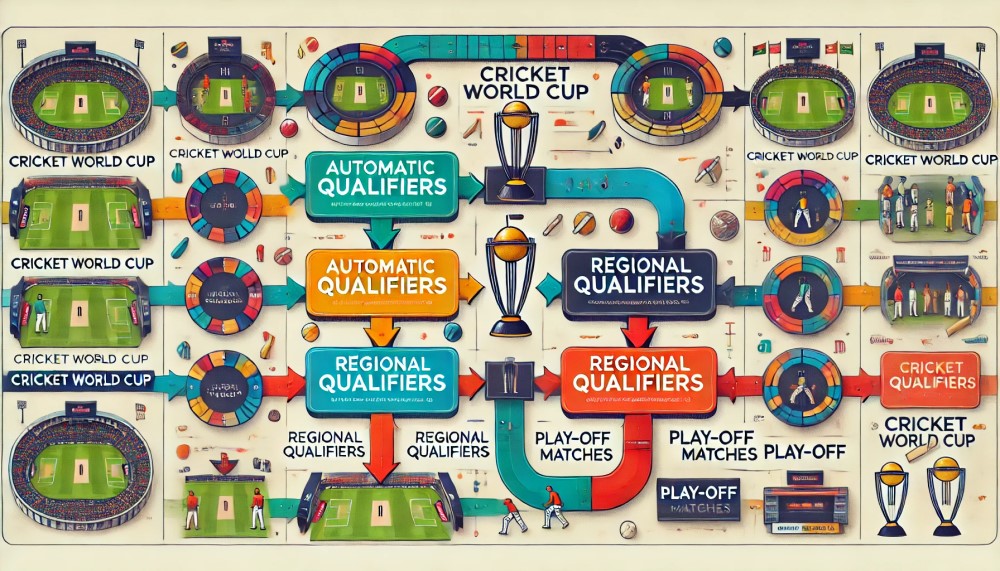
How Do Teams Qualify For The Cricket World Cup?
The Cricket World Cup is one of the most prestigious tournaments in the world of sports, drawing attention from millions of fans globally. It is a stage where the best cricketing nations compete for the ultimate prize in the sport. However, the journey to the World Cup is not straightforward. Teams must navigate through a rigorous qualification process to earn their spot in this coveted tournament. This article delves into the intricate process of how teams qualify for the Cricket World Cup, exploring the key tournaments, qualification criteria, and the evolution of the qualification system over the years.
Qualifying for the Cricket World Cup is a dream for every cricketing nation. The process involves a series of competitions and rankings that determine which teams make it to the grand stage. Understanding this process is crucial for fans and players alike, as it highlights the hard work, strategy, and dedication required to compete at the highest level.
Over the years, the qualification system has evolved to include more teams, making the tournament more competitive and inclusive. This evolution reflects the International Cricket Council‘s (ICC) commitment to growing the game globally and providing opportunities for emerging cricket nations.
The Structure of the Cricket World Cup

The International Cricket Council (ICC) is the governing body responsible for organizing the Cricket World Cup. The tournament typically features ten teams, although this number has varied in past editions. The competition format can include round-robin stages, group stages, and knockout rounds, ensuring that only the best teams progress through each phase. To maintain a high standard of competition, the ICC has implemented a comprehensive qualification system that involves a series of tournaments and criteria.
In the World Cup, teams compete in various formats depending on the edition. For instance, the 2019 Cricket World Cup featured a round-robin format where each team played against all other participating teams. This format ensured that the most consistent and capable teams advanced to the knockout stages. In contrast, earlier editions of the World Cup featured group stages where teams were divided into pools, with the top teams from each pool progressing to the knockout rounds. These different formats have been used to balance the need for competitive fairness and logistical feasibility.
The ICC continually assesses and refines the tournament structure to enhance competitiveness and viewership. The inclusion of associate members and emerging cricket nations has added new dimensions to the competition, providing more thrilling matches and unpredictable outcomes. This inclusivity not only enriches the tournament but also helps in the global development of the sport. As the ICC strives to make cricket a truly global game, the structure of the World Cup will continue to evolve to accommodate the changing dynamics of international cricket.
Historical Context and Evolution
The Cricket World Cup has undergone several changes since its inception in 1975. Initially, the tournament included a select few Test-playing nations. Over time, the ICC recognized the need to make the World Cup more inclusive and competitive. This led to the introduction of qualification tournaments, allowing non-Test playing nations a pathway to the World Cup. The evolution of the qualification process reflects the ICC’s commitment to promoting the game globally and providing opportunities for emerging cricket nations.
In the early years, the World Cup was dominated by traditional cricketing powerhouses like Australia, England, and the West Indies. These teams had automatic entry into the tournament, which limited opportunities for emerging cricket nations. However, as the popularity of cricket grew worldwide, there was a push to make the World Cup more representative of the global cricketing community. This led to the inclusion of associate members and the creation of a more structured qualification pathway.
One significant milestone in the evolution of the qualification process was the introduction of the ICC Trophy in 1979, which later became the ICC World Cup Qualifier. This tournament provided associate members with a competitive platform to vie for a place in the World Cup. The ICC also introduced regional qualifiers, giving teams from different continents a chance to compete on the global stage. These changes have made the World Cup more competitive and exciting, as teams from diverse backgrounds bring unique styles and strategies to the tournament.
The qualification process has continued to evolve with the introduction of the ICC Cricket World Cup League and the ICC Cricket World Cup Super League. These leagues provide a structured pathway for teams to earn points and improve their rankings, influencing their chances of qualifying for the World Cup. The inclusion of these leagues has added a new layer of competitiveness and has helped in identifying the best teams to compete in the World Cup. As cricket continues to grow, the qualification process will likely see further refinements to ensure that the best and most deserving teams participate in the World Cup.
The Qualification Process

The qualification process for the Cricket World Cup involves several stages and tournaments, designed to filter the best teams from around the world. The current structure includes direct qualification for the top teams and a qualification pathway for others through various tournaments.
For direct qualification, the ICC uses the ODI (One Day International) rankings. The top teams in these rankings earn automatic entry into the World Cup. This system rewards consistent performance over a four-year cycle, ensuring that the best teams based on recent form and results are included in the tournament. These rankings are determined by points accumulated through bilateral series and ICC events, with more weight given to recent matches.
Teams that do not qualify directly through the rankings have the opportunity to compete in the ICC Cricket World Cup Qualifier. This tournament is the final step in the qualification process and includes teams that have performed well in the ICC Cricket World Cup League, as well as winners from regional qualifiers. The ICC Cricket World Cup League is divided into several divisions, with teams competing over a period to earn points and improve their standings. The top teams from these divisions advance to the World Cup Qualifier.
The ICC Cricket World Cup Qualifier is a high-stakes tournament that determines the final spots for the World Cup. Teams from lower-ranked full members, top associate members, and winners from regional qualifiers compete in this tournament. The format usually includes a group stage followed by knockout rounds, ensuring a rigorous competition where only the best teams advance. The performance in the World Cup Qualifier is critical as it not only decides the World Cup participants but also impacts the ICC ODI rankings. Teams that perform well can improve their standings, enhancing their chances for direct qualification in future tournaments.
The qualification process is designed to ensure that the best teams, regardless of their status as full or associate members, have a fair chance to compete in the World Cup. This inclusivity is essential for the growth of cricket, as it encourages the development of the sport in non-traditional cricketing nations. The rigorous nature of the qualification process also ensures that teams are well-prepared for the challenges of the World Cup, leading to higher standards of competition and more exciting matches.
ICC Cricket World Cup Qualifier
The ICC Cricket World Cup Qualifier is a pivotal tournament in the qualification process. It determines the final teams that will participate in the World Cup. This tournament brings together the best non-qualifying teams from the ICC Cricket World Cup League and other regional competitions. The format usually includes a group stage followed by knockout rounds, ensuring a rigorous competition where only the best teams advance.
The World Cup Qualifier is often seen as a last-chance saloon for teams that have narrowly missed out on direct qualification. The stakes are high, and the competition is fierce, as teams vie for the remaining spots in the World Cup. The tournament is typically held a year before the World Cup, giving the qualifying teams ample time to prepare for the main event. The format of the qualifier usually mirrors that of the World Cup, with group stages followed by knockout rounds, ensuring that the teams are well-prepared for the rigors of the World Cup format.
Participation in the World Cup Qualifier is determined by performance in the ICC Cricket World Cup League and regional qualifiers. Teams that finish at the top of their respective divisions in the World Cup League earn a place in the qualifier. Additionally, the winners of regional qualifiers from Africa, Asia, Europe, and the Americas also earn a spot. This multi-tiered approach ensures that the best teams from around the world have a chance to compete for a place in the World Cup.
The World Cup Qualifier is not just a pathway to the World Cup but also a significant event in its own right. It provides a platform for emerging cricket nations to showcase their talent and gain valuable experience against higher-ranked teams. For many associate members, the qualifier represents a rare opportunity to compete on a global stage, attracting attention from fans, sponsors, and cricketing bodies. The intense competition and high stakes make the World Cup Qualifier an exciting and unpredictable tournament, often producing memorable matches and breakthrough performances.
The importance of the World Cup Qualifier extends beyond just qualification. Performance in this tournament can have a lasting impact on a team’s future. Teams that perform well can improve their ICC ODI rankings, enhancing their chances of direct qualification in future World Cups. The experience gained from competing in high-pressure matches against quality opposition is invaluable for player development and team growth. For emerging cricket nations, a strong showing in the qualifier can galvanize support and investment in the sport, contributing to the long-term development of cricket in their countries.
Regional Qualifiers and Associate Members

Regional qualifiers play a significant role in the World Cup qualification process, particularly for associate members and emerging cricket nations. These regional tournaments are held across different continents, including Africa, Asia, Europe, and the Americas. The winners of these tournaments earn spots in the ICC Cricket World Cup Qualifier, providing a pathway for smaller cricketing nations to compete on the world stage.
The regional qualifiers are crucial for the development of cricket in non-traditional cricketing regions. They offer competitive match experience and an opportunity to test skills against regional rivals. These tournaments are often fiercely contested, as they represent a chance for associate members to progress to the global stage and compete with more established cricketing nations.
Each region has its own qualification tournament, tailored to the specific needs and level of competition in that area. For example, the ICC Africa Qualifier features teams from across the African continent, while the ICC Americas Qualifier includes teams from North and South America. These tournaments typically follow a round-robin format, with the top teams advancing to the knockout stages. The winners of these regional tournaments earn a place in the ICC Cricket World Cup Qualifier, bringing them one step closer to the World Cup.
The inclusion of regional qualifiers in the World Cup qualification process underscores the ICC’s commitment to globalizing cricket and promoting the sport in non-traditional cricketing regions. It provides associate members with the opportunity to compete against higher-ranked teams, gain valuable experience, and improve their skills. The exposure and experience gained from participating in these tournaments are invaluable for the development of cricket in these regions.
For associate members, the path to the World Cup is challenging but rewarding. Competing in regional qualifiers and the World Cup Qualifier allows these teams to measure themselves against higher-ranked opponents, identify areas for improvement, and build on their strengths. The journey to the World Cup can be a transformative experience, providing players with the motivation and confidence to compete at the highest level.
The ICC’s investment in regional qualifiers and the development of associate members is essential for the growth of cricket. By providing more opportunities for competition and exposure, the ICC is helping to raise the standard of cricket globally and ensure that the World Cup remains a truly representative tournament. The inclusion of more teams from diverse backgrounds adds new dimensions to the competition, making it more exciting and unpredictable for fans around the world.
Impact of Rankings and Performance
The ICC ODI rankings are a crucial determinant in the qualification process for the Cricket World Cup. Teams accumulate points based on their performance in bilateral series and ICC tournaments. Consistent performance in these matches helps teams maintain or improve their rankings, securing direct qualification for the World Cup.
The ODI rankings are calculated using a complex formula that takes into account the quality of the opposition, the margin of victory, and the recentness of the matches. More recent matches carry greater weight, ensuring that the rankings reflect current form and performance. This system rewards teams that consistently perform well over a sustained period, ensuring that the best teams qualify for the World Cup.
For teams that do not qualify directly, their performance in the ICC Cricket World Cup League and regional qualifiers becomes paramount. Successful campaigns in these tournaments can lead to participation in the World Cup Qualifier, offering another chance to secure a spot in the World Cup. The performance in these tournaments also impacts the ICC ODI rankings, providing a pathway for teams to improve their standings and enhance their chances of direct qualification in future tournaments.
The rankings and performance in qualification tournaments are not just about earning a spot in the World Cup. They also have broader implications for the development of cricket in a country. Higher rankings and successful performances can attract more sponsorship, funding, and support from cricketing bodies and fans. This, in turn, can lead to better infrastructure, training facilities, and development programs, contributing to the long-term growth of the sport.
For associate members and emerging cricket nations, improving their ODI rankings and performing well in qualification tournaments is crucial for gaining recognition and support. It provides a platform to showcase their talent and potential, attracting attention from the global cricketing community. The experience and exposure gained from competing in high-stakes matches are invaluable for player development and team growth.
The impact of rankings and performance extends beyond just the teams and players. It also influences the overall competitiveness and excitement of the World Cup. By ensuring that the best and most deserving teams qualify, the ICC maintains the high standards of competition that the World Cup is known for. This, in turn, enhances the viewing experience for fans and promotes the global growth of cricket.
Challenges and Opportunities

The qualification process for the Cricket World Cup is rigorous and challenging, designed to ensure that only the best teams participate in the tournament. For associate members and emerging cricket nations, the path to qualification is particularly demanding. Competing against established cricketing powerhouses requires not only skill and strategy but also significant resources and support.
One of the main challenges for emerging cricket nations is the lack of infrastructure and funding. Many associate members do not have access to the same level of facilities, coaching, and support systems as full members. This makes it difficult to compete at the highest level and consistently perform well in qualification tournaments. Additionally, the financial strain of traveling and participating in international tournaments can be a significant barrier for many teams.
Despite these challenges, the qualification process also presents numerous opportunities. It allows emerging teams to showcase their talent on the international stage, gain exposure, and attract support from sponsors and fans. The experience gained from competing in high-stakes tournaments is invaluable for the development of players and the growth of cricket in these regions. Successful performances in qualification tournaments can also lead to increased funding and support, helping to address some of the infrastructure and resource challenges.
The ICC has recognized these challenges and is committed to supporting the development of cricket in emerging nations. This includes funding programs, development initiatives, and providing opportunities for competition and exposure. The inclusion of regional qualifiers and the ICC Cricket World Cup League in the qualification process is part of this effort to promote the global growth of cricket and provide a pathway for associate members to compete on the world stage.
For emerging cricket nations, the journey to the World Cup is both a challenge and an opportunity. It requires dedication, hard work, and strategic planning to navigate the qualification process and compete against higher-ranked teams. However, the rewards are significant, providing a platform to showcase their talent, gain valuable experience, and contribute to the growth of cricket in their regions. The ICC’s commitment to supporting these nations and promoting the global growth of cricket ensures that the World Cup remains a truly representative and competitive tournament.
The Road Ahead
The ICC continues to refine the World Cup qualification process, striving to make it more inclusive and competitive. Future editions of the World Cup may see changes in the number of participating teams and the structure of the qualification tournaments. The goal remains to balance the inclusion of emerging cricket nations with maintaining the high standards of competition that the World Cup is known for.
One potential change is the expansion of the World Cup to include more teams. This would provide more opportunities for associate members and emerging cricket nations to participate in the tournament. An expanded World Cup would also enhance the competitiveness and excitement of the tournament, providing more matches and a greater variety of teams and playing styles.
Another area of potential change is the structure of the qualification tournaments. The ICC may introduce new formats or pathways to ensure that the best teams qualify for the World Cup. This could include more regional qualifiers, expanded leagues, or additional tournaments to provide more opportunities for competition and exposure. The goal is to create a fair and transparent qualification process that ensures the best and most deserving teams participate in the World Cup.
The road ahead for the World Cup qualification process is one of continuous improvement and evolution. The ICC is committed to promoting the global growth of cricket and providing opportunities for emerging cricket nations to compete on the world stage. This includes addressing the challenges faced by these nations and providing the support and resources needed to develop their cricketing infrastructure and talent.
The future of the World Cup qualification process will be shaped by the ICC’s vision for the global growth of cricket. This includes promoting inclusivity, enhancing competitiveness, and ensuring that the World Cup remains a truly representative and prestigious tournament. The journey to the World Cup is a reflection of the hard work, dedication, and passion of cricketing nations around the world. By continuing to refine and improve the qualification process, the ICC ensures that the World Cup remains the pinnacle of international cricket, showcasing the best talent and providing thrilling and memorable matches for fans around the world.
Concluding the Journey to Cricket World Cup Qualification
Qualifying for the Cricket World Cup is a complex and demanding process that involves a series of tournaments, rankings, and criteria. The pathway to the World Cup is designed to filter the best teams from around the world, ensuring a high level of competition and excitement.
As the sport continues to grow globally, the qualification process will evolve, providing more opportunities for emerging cricket nations to compete at the highest level. Understanding this process not only enhances our appreciation of the World Cup but also highlights the immense effort and determination required to compete on this prestigious stage.





